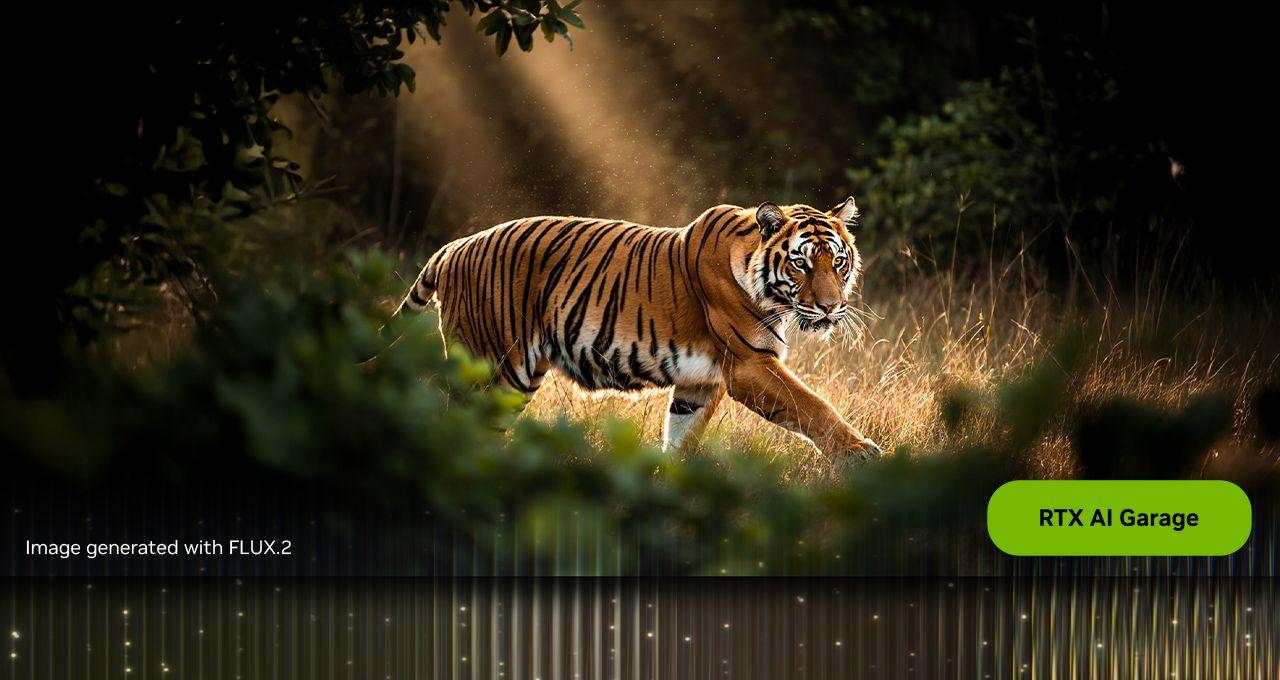Flux AI: The New Contender in AI Image Generation
3 Sources
3 Sources
[1]
How to Use Flux AI Image Generator For Free
Flux is an open-source AI model that is gaining traction for generating lifelike human images, even surpassing Midjourney in producing photorealistic images. So if you want to use this image generator for free, you have come to the right place. We have added four services that allow users to generate AI images using the Flux model. On that note, let's begin. You can use the Flux AI model to generate images on HuggingFace for free. The best part is that you don't have to sign up for an account. Flux is also available on NightCafe, but you only get 5 free credits. You can use one credit to generate a single AI image. So this is how you can use the Flux AI model to generate AI images for free. While the model is free and open-source, running such a large AI model requires compute and hardware resources. That's why services ask users to either sign up for an account or pay to continue using the model. Anyway, that is all from us. If you found this interesting, check out our list of the best AI art generators, both free and paid.
[2]
How to Make AI Images of Yourself With Flux
Creating personalized AI-generated images has never been easier, thanks to the innovative Flux platform. This comprehensive guide will walk you through the entire process, from setting up your account to sharing your final masterpieces. With Flux, you can unleash your creativity and produce stunning, one-of-a-kind images that showcase your unique style. The video below from Matt Wolfe shows you how to make AI Images of yourself. Flux is a innovative platform that harnesses the power of artificial intelligence to generate personalized images. With its intuitive interface and powerful tools, Flux empowers users to create visually striking images tailored to their specific preferences. Whether you're an artist, designer, or simply someone who appreciates the beauty of AI-generated art, Flux has something to offer. To embark on your Flux journey, you'll first need to set up an account. Visit the official Flux website and click on the prominent "Sign Up" button. Fill in the required information, such as your name, email address, and desired password. Once you've completed the registration process, verify your email address by clicking on the link sent to your inbox. With your account verified, you can now log in to Flux and explore its vast array of features. The key to creating stunning AI-generated images on Flux lies in the quality of the photos you upload. To begin, click on the "Upload" button within the Flux interface. Select the images you wish to use as the basis for your AI creations. For optimal results, ensure that your photos are clear, well-lit, and of sufficient resolution. High-quality input will yield high-quality output, so take the time to choose your best shots. Once your photos are uploaded, the real fun begins. Flux offers an extensive range of customization options, allowing you to fine-tune your image generation settings to achieve your desired aesthetic. Experiment with different styles, color palettes, and backgrounds to create truly unique compositions. The platform's intuitive controls make it easy to adjust settings and see the impact of your choices in real-time. After the AI has worked its magic, it's time to review the generated images. Flux provides a user-friendly interface for refining and enhancing your creations. Carefully examine each image, paying attention to details, composition, and overall impact. If you spot areas that need improvement, use Flux's editing tools to make precise adjustments. Tweak settings, apply filters, and experiment with different variations until you're completely satisfied with the results. Once you've perfected your AI-generated images, it's time to share them with the world. Flux makes it easy to export your creations in various formats, ensuring compatibility across different platforms. Click on the "Export" button and select your preferred file type, such as PNG or JPG. From there, you can seamlessly share your images directly to social media channels or download them for personal use. Watch as your unique AI artistry captivates and inspires others. To get the most out of Flux, consider these tips and best practices: In the event that you encounter any issues or have questions along the way, Flux provides a comprehensive troubleshooting guide and dedicated support team. Common challenges may include image distortion, poor quality output, or difficulty navigating the platform. By consulting the troubleshooting resources and reaching out to Flux's knowledgeable support staff, you can quickly overcome any obstacles and continue creating stunning AI-generated images. With Flux, the possibilities for creating personalized AI images are endless. By following this step-by-step guide and leveraging the platform's powerful tools, you can unleash your creativity and produce visually striking images that reflect your unique style. So, dive in, experiment, and let your imagination run wild. The world of AI-generated art awaits, and Flux is your gateway to unlocking its full potential.
[3]
Flux vs Midjourney: Is There a New AI Image Generator Champ?
In its current stage, it's not as feature-rich as Midjourney, but it's cheaper and easier to access. Till now, Midjourney has been ranked as the best AI image generator, and rightly so. However, a new open-source model called Flux. 1 has been released by Black Forest Labs, and it has quickly become a sensation for generating photorealistic images. In this Flux vs Midjourney comparison, we'll check which tool is better at generating images, depicting human features and the images look quite surreal. The realism in generated photos is pretty remarkable. Flux. 1 is an open-source AI model for generating images, and it's developed by former Stable Diffusion engineers and researchers. Under the new AI startup called Black Forest Labs, three new Flux. 1 models have been released. Flux. 1 [pro] is the state-of-the-art model, and it's for commercial use only. Flux. 1 [dev] and Flux. 1 [schnell] models are open-source and the AI community has already improved the models for generating photorealistic images. With a Realism LoRA adapter, the Flux. 1 [dev] model is able to generate visually realistic images and the hands are depicted without any distortion or artifacts. Again, Flux's output is more realistic and believable than Midjourney's result. Midjourney's image looks like a painting, whereas Flux generates a lifelike depiction. In this test, both images generated by Flux and Midjourney don't pass the sniff test. Both images look AI-generated, but Midjourney's result demonstrates better handling of reflections and lighting. Here, I would pick Flux's output as it depicts imagery straight out of a fantasy. Midjourney's generated image is also pretty detailed. This one would be a tie, but Flux's image is a bit clean, whereas Midjourney has generated a visually complex image. Finally, in text rendering, both Flux and Midjourney did a great job. This is one area where image synthesis models struggle, but it's a good sign that an open-source model is able to compete with a closed-source model like Midjourney. Winner: Flux Now, coming to pricing, well we know that Flux is free and open-source, but to run the model locally, you will need beefy specs with a dedicated GPU. It's a 12 billion parameter model, after all. The best way to run Flux on local hardware is through Pinokio (website). Download the app and get started with Flux. Apart from that, there are many service providers that allow you to generate images using the Flux model for free. However, those come with limited free credits or the image generation might take considerable time, depending on the system load. You can head over to HuggingFace (website) to use the Flux. 1 [dev] model for free. In addition, you can check out fal.ai (website) where LoRA models are also available, but you only get $1 worth of free credits. After that, you will have to buy more credits based on your usage. As for Midjourney, it's expensive, and it costs $10 per month when billed monthly. But the good part is that image generation is pretty fast, and you get a slick UI to boot. Winner: Flux Since Flux is a new model in town, it doesn't offer many AI image editing features out of the box. But there are some services like BasedLabs (website) that allow you to upscale images, and define the aspect ratio. You can also choose how many images you want to generate at once. And if you are a technical user, you can play with seed value, steps count, and de-noise settings as well. Midjourney, on the other hand, is more feature-rich and supports many features. To begin with, you can set the aspect ratio, choose your aesthetics, and stylization. You can even use older Midjourney models, and create a natural-looking images using the Raw option. Moreover, after an image is created, you can choose to upscale the image, zoom out and add more details, do inpainting using the lasso tool, reframe it, and much more. Basically, you can modify an image by running new prompts, which is awesome. So for inpainting and outpointing needs, Midjourney offers more tools and controls than Flux, as of now. Winner: Midjourney If you are an artist, you would want the service to support the Content Credentials standard. It helps in finding information about the origin of the image, and whether it has been modified. Sadly, neither Midjourney nor Flux support the Content Credentials standard. These services don't add any sort of verifiable metadata in their generated AI images. Winner: Neither So that wraps up our comparison between Flux and Midjourney. I am very impressed with the Flux model, and it stands as a capable and free alternative to Midjourney. The open-source community can build upon it and add features like inpainting and outpainting as well. Anyway, that is all from us. If you have any questions, let us know in the comments below.
Share
Share
Copy Link
Flux AI emerges as a powerful new AI image generator, challenging established platforms like Midjourney. This web-based tool offers unique features and impressive capabilities for creating high-quality images from text prompts.

Introduction to Flux AI
Flux AI has recently entered the arena of AI image generation, positioning itself as a formidable competitor to established platforms like Midjourney and DALL-E. This web-based tool has garnered attention for its ability to create high-quality images from text prompts, offering users a new avenue for creative expression
1
.How Flux AI Works
Flux AI operates on a simple yet powerful premise: users input text descriptions, and the AI generates corresponding images. The platform is accessible through a web interface, eliminating the need for software downloads or installations. Users can create an account and start generating images immediately, with options for both free and paid tiers
2
.Key Features and Capabilities
One of Flux AI's standout features is its intuitive user interface, which allows for easy manipulation of generated images. Users can adjust various parameters such as aspect ratio, image quality, and generation speed. The platform also offers a unique "remix" feature, enabling users to modify existing images with new prompts
1
.Flux AI supports a wide range of artistic styles and can generate images in various formats, including illustrations, photographs, and 3D renders. The AI has been trained on a diverse dataset, allowing it to understand and interpret complex prompts effectively
2
.Flux AI vs. Midjourney: A Comparison
When compared to Midjourney, one of the leading AI image generators, Flux AI holds its own in terms of image quality and versatility. Tests have shown that Flux AI excels in certain areas, particularly in generating realistic human faces and detailed environments
3
.However, Midjourney still maintains an edge in some aspects, such as consistency across multiple generations and handling complex, multi-element prompts. The competition between these platforms is driving rapid improvements in AI image generation technology
3
.Related Stories
Pricing and Accessibility
Flux AI offers a free tier that allows users to generate a limited number of images per day. For more intensive use, the platform provides paid plans with additional features and higher generation limits. This tiered approach makes Flux AI accessible to casual users while also catering to professionals and heavy users
2
.Impact on Creative Industries
The emergence of tools like Flux AI is reshaping various creative industries, including graphic design, advertising, and digital art. These AI image generators are not only streamlining the creative process but also opening up new possibilities for visual expression. As the technology continues to evolve, it's likely to have far-reaching implications for how visual content is created and consumed
1
.References
Summarized by
Navi
[2]
Related Stories
Recent Highlights
1
OpenAI releases GPT-5.2 AI model after code red memo targets Google's Gemini 3 threat
Technology

2
Disney invests $1 billion in OpenAI, licenses 200+ characters for Sora AI video generator
Technology

3
OpenAI faces wrongful death lawsuit after ChatGPT allegedly fueled murder-suicide tragedy
Policy and Regulation








